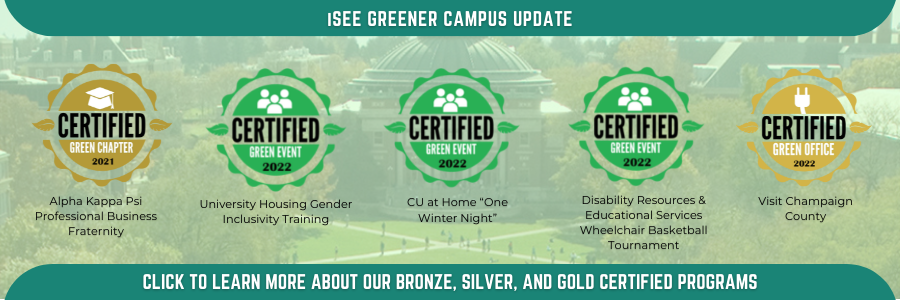You are here
Project Updates for collection: all
Search
Search tips:
- This form will search for words in the title OR the description. If you would like to search for the same term(s) across both the title and description, enter the same search term(s) in both fields.
- This form will search for any of the words you enter in a field, not the exact phrase you enter. If you would like to search for an exact phrase, put double quotes (") around the phrase. For example, if you search for Bike Path you will get results containing either the word Bike OR the word Path, but if you search for "Bike Path" you will get results containing the exact phrase Bike Path.
Tracking Water Irrigation on Campus
Associated Project(s):F&S compiled this list of meters that track irrigation usage (which is attached below).
Note this is not a complete record of irrigation watering on campus.
Attached Files:Resilience iCAP Team February Meeting
Associated Project(s):On Friday, February 4th, the Resilience iCAP Team had their first meeting of the semester. The team discussed updates on projects such as the Biodiversity Plan, Local Carbon Offsets and a potential Environmental Justice Reading group. Meeting minutes are attached.
Attached Files:Weekly Update: Uni High Agora Days classes; Maintenance Class
Associated Project(s):All, Last week we held our Uni High Agora Days classes from Tues – Fri. It went very well with all the students engaged in learning and tinkering on the bikes. One student even said they’d return to volunteer, which was great. All 3 of the bikes were mostly done by week’s end. We also received some quality donations from a local bike shop and started overhauling those bikes for sale. I’ve also hired a new Program Assistant to help me out off-hours.
This week I’ll be meeting with the Urbana Parks District to discuss our Maintenance class we’re collaborating on next month and getting more bikes ready for the sales floor. We’ll see how busy we are today with the very warm weather.
The numbers:
Visitors: 11
Sales: $91
Memberships: 2 for $60Thanks!
Jacob Benjamin
Campus Bike Center CoordinatorZero Waste Meeting
Associated Project(s):The Zero Waste team met on Monday, February 21 to draft a recommendation on reducing single-use plastics on campus--particularly in vending machines. This recommendation, along with the other teams drafted by the team last semester, will be presented at an upcoming Sustainability Sub-council.
Attached Files:Zero Waste Meeting
Associated Project(s):The Zero Waste team met on Monday, February 21 to draft a recommendation on reducing single-use plastics on campus--particularly in vending machines. This recommendation, along with the other teams drafted by the team last semester, will be presented at an upcoming Sustainability Sub-council.
Attached Files:Mode Choice Survey 2022
Associated Project(s):After discussions internally at F&S (in the Sustainability and Transportation Demand Management departments) and then discussions with iSEE, it was agreed that the F&S TDM department will conduct the Mode Choice Survey in 2022 and every 3 years going forward.
This Week in Research
Associated Project(s):UIUC ranks 25th on the EPA's top-30 list of the largest on-site green power users in the Green Power Partnership, joining prominent companies Apple, Procter & Gamble, Target, Intel, and more.
2021 Tree Campus Higher Education Application Approved by the Arbor Day Foundation
Associated Project(s):The University of Illinois Urbana-Champaign has once again been recognized by the Arbor Day Foundation as a Tree Campus USA member. Specifically, the Tree Campus High Education program reviewed the Tree Care Plan, in addition to other requirements, to grant our campus the title of an offical Tree Campus. Below is a brief summary of what is needed to obtain this recoginition, each year.
"To obtain this distinction, your campus has met the five core standards for sustainable campus forestry required by Tree Campus Higher Education, including establishment of a tree advisory committee, evidence of a campus tree care plan, dedicated annual expenditures for your campus tree program, an Arbor Day observance, and the sponsorship of student service learning projects. Your entire campus community should be proud of this sustained commitment to environmental stewardship."
Engagement iCAP Team Meeting
Associated Project(s):The Engagement iCAP Team met on Friday, February 18 to discuss current ongoing recommendations, including: Sustainability TikTok challenge, College of Engineering Sustainability Leaders Learning Session, and a Sustainability Partnership with the ADV498 Advertising Capstone Course. Meeting minutes are attached.
Attached Files:UIUC Ranks #25 Nationally on EPA's List of On-Site Green Power Users
Associated Project(s):The newsletter attached below is from F&S Customer Relations & Communications, which provides more detail on UIUC's Green Power User achievement.
Attached Files:SSC Semesterly Report: Bike Registration Signs
Associated Project(s):SSC received semester report for Fall 2021 for Bike Registration Signs project on January 6, 2022. Please see attached.
Attached Files:Online LEED Green Associate Training
Associated Project(s):The following text is taken from the February iSEE Newsletter, which is attached below.
LEED Green Associate Training Offered Online. Students can prepare for the LEED Green Associate exam through this online course offered by LeadingGreen and taught by a U.S. Green Building Council faculty member. Register for a live webinar or complete the on-demand recordings at your own pace. Questions? Watch this introductory video or email Lorne Mlotek at info@leadinggreen.com.
Live webinars Feb. 24, March 12, April 2, April 23, May 15 | Register hereAttached Files:"Recycling 101: Start With Reduce, Reuse" -iSEE Newsletter
Associated Project(s):The following passage is taken from an iSEE February Newsletter (the newsletter is attached below).
Recycling 101: Start With Reduce, Reuse
Did you know less than 10 percent of plastic is recycled each year? Or that cardboard contaminated with grease or food can't be recycled? In "Recycling 101," iSEE intern Maria Maring outlines what can and can't be recycled on campus, recycling rules and resources in Champaign-Urbana, and tips from sustainability experts about what you can do to recycle effectively and keep waste out of the landfill. Most important: Remember that recycling is just one of the "three Rs," and that "reuse" and "reduce" are just as important in shrinking your environmental footprint!
Attached Files:iSEE Greener Campus Update (Picture)
Associated Project(s):
Geothermal Urbana-Champaign 2.0 Spring Zoom Sessions
Associated Project(s):The following text is from the February iSEE Newsletter, which is attached below.
Geothermal Urbana-Champaign 2.0 Starts Feb. 23. Geothermal Urbana-Champaign is a public education and group buy program that makes getting geothermal heating and cooling easier and more affordable for Champaign, Piatt, and Vermilion County home and business owners. Register for a spring Zoom session to learn more! Spring dates include Feb. 23, March 29, April 12 (co-hosted by iSEE and F&S), May 2, and May 23 (times vary). Details>>>
Attached Files:Weekly Update: Build-a-bike, Uni High Agora Days class
Associated Project(s):All, Picked up 4 – 5 bikes from Urbana last week which were promptly claimed as B-a-Bs or tagged for shop builds. This week we have our Uni High Agora Days class coming in Tues – Fri. This will reduce our open hours on Wed/Fri to 4 – 6p.
I’ll be picking up 5 bikes from Champaign Cycle on Tuesday afternoon, too. That should get us towards a good number of bikes on hand.
The numbers:
visitors: 10
Sales: $324
Bike (refurb): 1 for $180
Memberships: 3 for $90
Thanks!Jacob Benjamin
Campus Bike Center CoordinatorNew iSEE Green Event Certifications
Associated Project(s):Congratulations to the newest recipients of our Green Event Certification Program!
DRES Wheelchair Basketball Tournament-Certified January 2022
Illinois Extension Everyday Environment Webinar Series-Certified February 2022
Thank you for you sustainability initiatives, keep up the great work!
HVAC and Air Quality Assessment Project Meeting (2-11-2022)
Associated Project(s):Dhuvaraj Gambhire and Ali Khan met with Morgan White on 2-11-2022 to discuss how they can acquire a Notice to Proceed and access to the Atmospheric Science Building for testing.
They will get a quote from Sterling, which will allow them to get a Purchase Order (PO). After they get the PO, they can get a Notice to Proceed and access to the building.
Campus Tree Advisory Committee Meeting - February 2022
Associated Project(s):On February 10, 2022, the 2022 Campus Tree Advisory Committee met to complete the following:
- Review the charge letter
- Discuss the success of the 2022 Tree Campus Plan
- Plan Arbor Day 2022 events
- Discuss policy revisions regarding tree damage replacements
- Discuss the creation of a campus nursery
See the attached file to read the meeting notes.
Attached Files:
